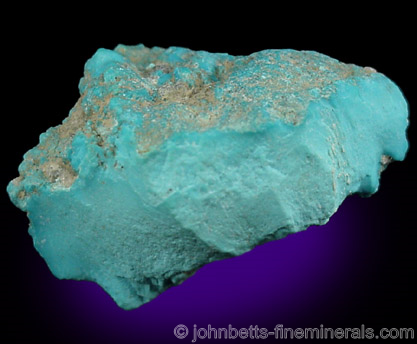The Mineral turquoise

Turquoise is an antique ornamental stone, highly regarded for its unique and striking namesake color. Valued in both the ancient Persian and Native American civilizations, it still retains its popularity today. Turquoise specimens are often polished or sliced for collectors, and may even be dyed. Turquoise is porous and has a naturally waxy luster; it is sometimes impregnated with a plastic lubricant for to enhance its luster and increase its stability. Many Turquoise fakes exist. The most prevalent is white Howlite dyed blue to resemble Turquoise.
Turquoise often contains embedded shiny Pyrite flakes, or may contain black oxide veins running through it. It is sometimes intergrown together with other secondary copper materials, especially Chrysocolla. Turquoise may also form as a pseudomorph of other minerals such as Apatite, Beryl, and feldspars.
For additional information, see the gemstone section on Turquoise.
Chemical Formula
CuAl6(PO4)4(OH)8 • 4H2O
Color
Turquoise-blue, sky-blue, bluish-green, apple-green
Properties
Streak
White |
Hardness
5 - 6 |
Transparency
Opaque. May be translucent in thin sections. |
Specific Gravity
2.6 - 2.8 |
Luster
Waxy, dull |
Cleavage
None |
Fracture
Conchoidal |
Tenacity
Brittle |
Varieties
-
Turquoise from the Mineral Park Mine near Kingman, Arizona, known for its good color.
Uses
Turquoise is an important gemstone. Its bright color has afforded it important gem use throughout several ancient civilizations, and today it remains an important yet affordable gemstone. Turquoise gemstones are usually cabochons and beads, but may also be ornate carvings of animals and flowers. Turquoise specimens are also popular among mineral collectors, and the crystallized form from Virginia is especially highly desired and valuable.
Noteworthy Localities
Though Turquoise is found worldwide, the vast majority of Turquoise originates from the southwestern United States. However, one of the most important and classic localities is Nishapur, Iran, where Turquoise has been mined since the ancient Persians. Other historical localities for Turquoise are Serabit el-Khadim in the Sinai Peninsula, Egypt; and Eilat, Israel, where it is associated with Chrysocolla and called "Eilat Stone". Mexico has several important Turquoise localities, including odd pseudomorphs after Apatite in Cananea and Baviacora, Sonora.
In the U.S., huge nodular Turquoise masses come from several areas in Lander Co., Nevada, especially at the Cortez and Bullion Districts. Ball-like microcrystal aggregates come from the Silver Coin Mine, Valmy, Humboldt Co., Nevada; and a rare Turquiose pseudomorph after Beryl was found in the Apache Canyon Mine, near Baker, San Bernardino Co., California. Turquoise of excellent color and quality is well known at Kingman, Mohave Co., Arizona, where rare tiny crystals were also recently found in drusy habit. Other important Turquoise deposits include the Copper Cities Mine, Globe-Miami District, Gila Co., Arizona; the No. 8 Mine, Lynn District, Eureka Co., Nevada; and the Bingham Canyon Mine, Salt Lake Co., Utah. The best and most apparent crystals of Turquoise, in the form of visible microcrystals, come from Lynch Station, Campbell Co., Virginia.
Distingushing Similar Minerals
Turquoise may be very similar and very difficult to distinguish from Variscite, though Variscite is usually greener. Chrysocolla may also be similar though it is lower in hardness and usually has a more vitreous luster.